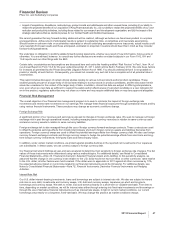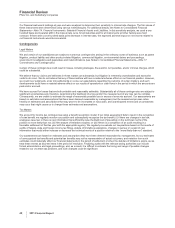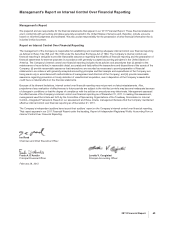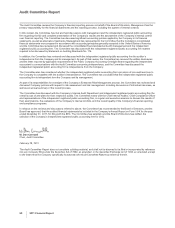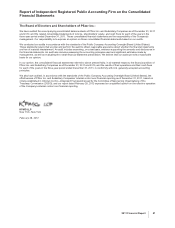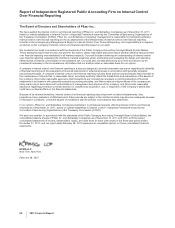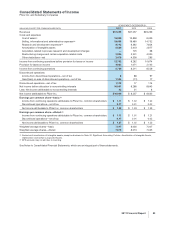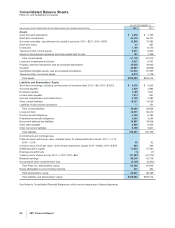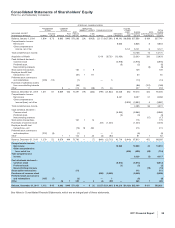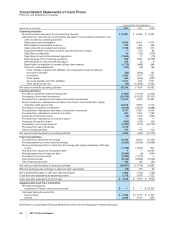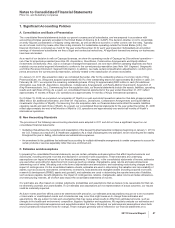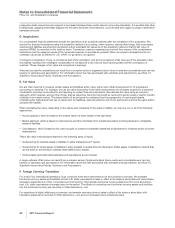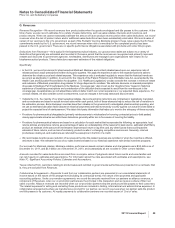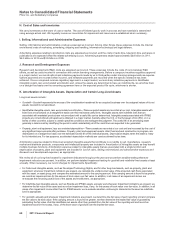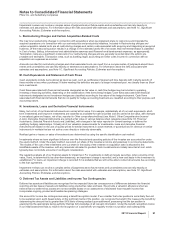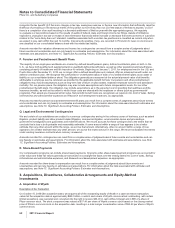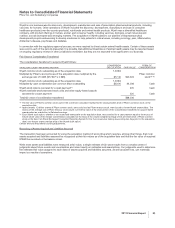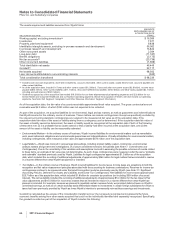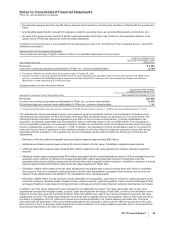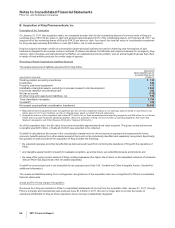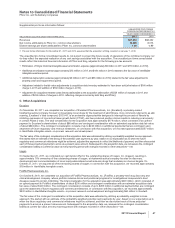Pfizer 2011 Annual Report Download - page 58
Download and view the complete annual report
Please find page 58 of the 2011 Pfizer annual report below. You can navigate through the pages in the report by either clicking on the pages listed below, or by using the keyword search tool below to find specific information within the annual report.
Notes to Consolidated Financial Statements
Pfizer Inc. and Subsidiary Companies
1. Significant Accounting Policies
A. Consolidation and Basis of Presentation
The consolidated financial statements include our parent company and all subsidiaries, and are prepared in accordance with
accounting principles generally accepted in the United States of America (U.S. GAAP). The decision whether or not to consolidate
an entity requires consideration of majority voting interests, as well as effective economic or other control over the entity. Typically,
we do not seek control by means other than voting interests. For subsidiaries operating outside the United States (U.S.), the
financial information is included as of and for the year ended November 30 for each year presented. Substantially all unremitted
earnings of international subsidiaries are free of legal and contractual restrictions. All significant transactions among our businesses
have been eliminated.
As a result of our decision to sell our Capsugel business, we show the operating results of Capsugel as Discontinued operations—
net of tax for all periods presented (see Note 2D. Acquisitions, Divestitures, Collaborative Arrangements and Equity-Method
Investments: Divestitures). Also, due to a change in management approach, we now have different operating segments and have
restated our prior period segment information to conform to the current period presentation (see Note 18A. Segment, Geographic
and Other Revenue Information: Segment Information). In addition, we made certain reclassification adjustments to conform prior-
period amounts to the current period presentation, primarily related to the classification of certain receivables.
On January 31, 2011 (the acquisition date), we completed the tender offer for the outstanding shares of common stock of King
Pharmaceuticals, Inc. (King) and acquired approximately 92.5% of the outstanding shares for approximately $3.3 billion in cash. On
February 28, 2011, we acquired the remaining outstanding shares of King for approximately $300 million in cash (for additional
information, see Note 2B. Acquisitions, Divestitures, Collaborative Arrangements and Equity-Method Investments: Acquisition of
King Pharmaceuticals, Inc.). Commencing from the acquisition date, our financial statements include the assets, liabilities, operating
results and cash flows of King. As a result, our consolidated financial statements for the year ended December 31, 2011 reflect
approximately 11 months of King’s U.S. operations and approximately 10 months of King’s international operations.
On October 15, 2009, we completed our acquisition of Wyeth in a cash-and-stock transaction valued on that date at approximately
$68.2 billion (for additional information, see Note 2A. Acquisitions, Divestitures, Collaborative Arrangements and Equity-Method
Investments: Acquisition of Wyeth). Commencing from the acquisition date, our financial statements reflect the assets, liabilities,
operating results and cash flows of Wyeth. As a result, our consolidated financial statements for the year ended December 31, 2009
reflect approximately two-and-a-half months of Wyeth’s U.S. operations and approximately one-and-a-half months of Wyeth’s
international operations.
B. New Accounting Standards
The provisions of the following new accounting standards were adopted in 2011 and did not have a significant impact on our
consolidated financial statements:
•Guidelines that address the recognition and presentation of the fee paid by pharmaceutical companies beginning on January 1, 2011 to
the U.S. Treasury as a result of U.S. Healthcare Legislation. As a result of adopting this new standard, we are recording the fee ratably
throughout the year in Selling, informational and administrative expenses.
•An amendment to the guidelines that address the accounting for multiple-deliverable arrangements to enable companies to account for
certain products or services separately rather than as a combined unit.
C. Estimates and Assumptions
In preparing the consolidated financial statements, we use certain estimates and assumptions that affect reported amounts and
disclosures, including amounts recorded and disclosed in connection with acquisitions. These estimates and underlying
assumptions can impact all elements of our financial statements. For example, in the consolidated statements of income, estimates
are used when accounting for deductions from revenues (such as rebates, chargebacks, sales returns and sales allowances),
determining cost of sales, allocating cost in the form of depreciation and amortization, and estimating restructuring charges and the
impact of contingencies. On the consolidated balance sheets, estimates are used in determining the valuation and recoverability of
assets, such as accounts receivables, investments, inventories, fixed assets and intangible assets (including acquired in-process
research & development (IPR&D) assets and goodwill), and estimates are used in determining the reported amounts of liabilities,
such as taxes payable, benefit obligations, the impact of contingencies, rebates, chargebacks, sales returns and sales allowances,
and restructuring reserves, all of which also impact the consolidated statements of income.
Our estimates are often based on complex judgments, probabilities and assumptions that we believe to be reasonable but that can
be inherently uncertain and unpredictable. If our estimates and assumptions are not representative of actual outcomes, our results
could be materially impacted.
As future events and their effects cannot be determined with precision, our estimates and assumptions may prove to be incomplete
or inaccurate, or unanticipated events and circumstances may occur that might cause us to change those estimates and
assumptions. We are subject to risks and uncertainties that may cause actual results to differ from estimated amounts, such as
changes in the healthcare environment, competition, litigation, legislation and regulations. We regularly evaluate our estimates and
assumptions using historical experience and expectations about the future. We adjust our estimates and assumptions when facts
and circumstances indicate the need for change. Those changes generally will be reflected in our financial statements on a
2011 Financial Report 57


